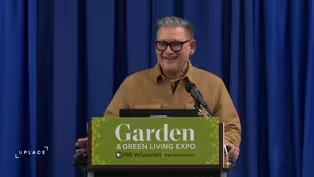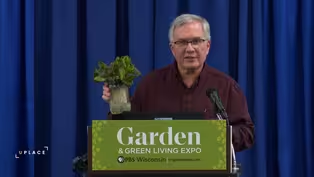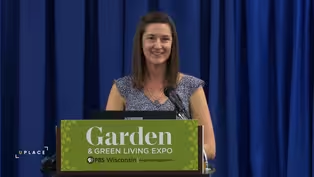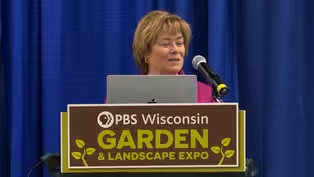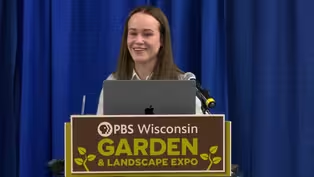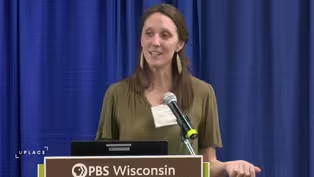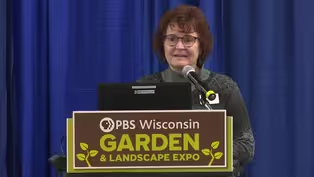
Wonderful Wool for Your Plants and Your Planet
Special | 48m 2sVideo has Closed Captions
Elaine Becker and Karen Mayhew describe how wool is a healthy soil alternative to peat.
Woollets owners Elaine Becker and Karen Mayhew describe how wool is a sustainable, organic soil alternative to peat. They explain how wool offers better moisture retention, synthetic amendments and nutrition than peat, all while aerating, improving soil health and repelling pests.
Problems playing video? | Closed Captioning Feedback
Problems playing video? | Closed Captioning Feedback
University Place is a local public television program presented by PBS Wisconsin
University Place is made possible by the Corporation for Public Broadcasting.

Wonderful Wool for Your Plants and Your Planet
Special | 48m 2sVideo has Closed Captions
Woollets owners Elaine Becker and Karen Mayhew describe how wool is a sustainable, organic soil alternative to peat. They explain how wool offers better moisture retention, synthetic amendments and nutrition than peat, all while aerating, improving soil health and repelling pests.
Problems playing video? | Closed Captioning Feedback
How to Watch University Place
University Place is available to stream on pbs.org and the free PBS App, available on iPhone, Apple TV, Android TV, Android smartphones, Amazon Fire TV, Amazon Fire Tablet, Roku, Samsung Smart TV, and Vizio.
More from This Collection
Video has Closed Captions
Patrick Smith uses principles of improv comedy to create a sustainable garden. (49m 23s)
Indoor Gardening for Food and Fun
Video has Closed Captions
Victor Zaderej offers practical advice on how to easily grow produce indoors. (49m 6s)
New and Unique Plant Varieties
Video has Closed Captions
Horticulture specialist Allen Pyle showcases standout plants from 2024 trial gardens. (45m 16s)
Video has Closed Captions
Rachel Belida presents ideas for creating a seven-layer food forest in your yard. (45m 45s)
Video has Closed Captions
Becky Gutzman shows how to safely preserve your summer garden bounty for the rest of the year. (58m 35s)
Simple Steps to a Beautiful Rose Garden
Video has Closed Captions
Diane Sommers shares suggestions on growing roses for the home gardener. (47m 50s)
Video has Closed Captions
Alena Joling explains how to take care of your bladed garden tools. (50m 25s)
Preventing Bird-Window Collisions at Your Home
Video has Closed Captions
Brenna Marsicek explains why birds hit windows and how to make windows more bird-safe. (48m 47s)
Legacy Trees and the Prairie Savanna Project
Video has Closed Captions
Matt Noone and Cindy Becker introduce two Dane County area community science projects. (48m 14s)
Video has Closed Captions
Lisa Johnson offers best practices and tips for successful container gardening. (50m 16s)
Video has Closed Captions
Johanna Oosterwyk explores the promise and pitfalls of vertical farming. (50m 58s)
Video has Closed Captions
Dan Goodspeed shares advice for achieving seed germination success. (54m 38s)
Providing Support for PBS.org
Learn Moreabout PBS online sponsorship- Elaine Becker: Human legacy of environmental damage to the water, air, and ground of this world is not one thing, but nearly too many to count.
Nevertheless, we still must each face the environmental challenges, doing what each of us can in our own way to help preserve our environment.
Good morning, thank you for joining us today.
My name is Karen Mayhew, and I'm a fourth-generation farmer, a shepherd, and I'll be finishing up master gardener certification next month.
[audience applauding] Thank you, life goal achieved.
My day job is at the local U.S. post office in our town, and I grew up on a very large market vegetable, cash crop, and poultry farm back in Maryland.
Now I farm sheep with my family.
We have about 25 acres with a farm stay in our barn, and miscellaneous chickens, goats, cats, rabbits.
You name it, it's there.
And a flock of about 50 heritage breed sheep.
Now, 50 sheep produce a lot of wool.
And although I spin and knit, I'm always looking for creative ways to use that fiber to keep it out of my garage.
So mostly I try to use it, but a lot of it ends up in the garden to benefit the soil.
So we'll talk to you about that today.
And this is my business partner.
- I am Elaine Becker.
I'm an educator and a librarian by day at a tiny rural school here in Wisconsin.
I received a BS in environmental science from Indiana University.
Go, IU.
And I'm currently becoming a master naturalist.
- Whoo-hoo!
- Growing up, my family had extremely large gardens, and I grew up watching and helping my folks preserve all the vegetables, canning, drying.
We probably had fruit leathers before anyone else ever had Fruit by the Foot roll-ups or whatever that's called.
Many summer days, my siblings and I could be seen picking beans, weeding, mulching, picking beans, weeding, mulching.
[all laughing] And at the time, I didn't appreciate it.
I did feel like we ate like kings, though.
So I'm an environmentalist, a plant lover, a geeky prairie lover, and I want the best for our environment.
[audience applauding] [Karen chuckles] - So our company turns wool into Woollets wool pellets.
We source our wool from Wisconsin sheep farmers, paying them a fair price and adding revenue to their farms and their families.
We divert that wool from the waste stream.
And we shred it-- nope.
- Elaine: It sped through.
- Karen: Okay, well, I'll just wing it.
We shred that wool in a machine with nine whirling blades of death.
Her name is Wilma, by the way.
[audience laughing] And that turns the wool into tiny pieces.
And then we pellet it using heat and pressure in Betty, our pellet mill.
All right, so, did I get-- oh, here we go.
Well, yeah, this...
I am very technologically challenged, guys.
I'm terribly sorry.
So the wool pellets are actually a lot easier to use than storing whole fleeces.
And switching to wool is great for your plants and your planet.
Wool is a sustainable alternative to peat moss for moisture retention, and wool, unlike peat, has lots of nutrients for the soil and your plants.
- Elaine: In our first year of business, Karen and I have some things to celebrate.
Woollets has diverted 18,000 pounds of wool from the landfills.
Karen.
- Karen: Yes.
[audience applauding] We have provided Wisconsin shepherds a new market for that 18,000 pounds of wool.
And finally, in the fall of 2024, we were nominated for and won a Wisconsin Innovation Award for agriculture.
[audience applauding] Thank you.
Little disclaimer, We didn't expect to win.
We were going to the UW celebration for the hors d'oeuvres, and... [audience laughing] ...and the live band.
And lo and behold, we were surprised.
We were up against some tough competition, but we won.
- Karen: It was exciting.
- So today, we're here to talk to you about the benefits of using wool in your gardens.
First, we'll discuss peat and the need for using sustainable alternatives due to peat's important function as a carbon sink.
Next, we'll focus on nutrients wool can provide for your vegetables: both macronutrients, which plants need in large quantities, as well as micronutrients, which plants need in smaller quantities.
We'll discuss soil life, which plays a very important role in the health of your plants and the quality of the vegetables you grow.
We'll talk about moisture balancing.
We'll talk about aeration.
And finally, we'll go over the different ways to use wool throughout each season.
In the overview, I mentioned peat bogs.
Let me explain about peat bogs, which are one of the world's largest carbon sinks.
Carbon sinks hold and store or sequester carbon in the ground, keeping it out of the atmosphere.
Carbon emissions drive extreme weather.
According to the National Oceanic Atmospheric Administration, NOAA, CO2 is responsible for 76% of the greenhouse gas emissions.
Some of our largest and best carbon sinks are the oceans, forests, and peatlands.
Peatlands are fantastic for absorbing carbon because there's no limit on the amount of absorption.
Peatlands store more carbon than rainforests.
That's incredible.
They're incredibly important for our climate.
Digging up peat releases their stored carbon into the atmosphere, it contributes to warming temperatures, and it accelerates climate change.
Peat rebuilds at a tiny rate of 1/16 of an inch per year.
These bogs are formed over thousands of years, taking centuries to develop.
Peat consumption is far greater than peat creation, making it unsustainable.
Peat is also harvested using large equipment powered by fossil fuels.
The main benefit of peat is its use as a moisture-retaining medium and soil acidifier.
Peat is devoid of nutrients and is mostly used as a filler in potting soils.
Unlike organic materials such as manure or compost, peat, being devoid of nutrients, doesn't contain any helpful microbes for your soil.
So that means you can use peat as an amendment to acidify or retain some moisture, but you can't use it alone and expect the plants will grow strongly and properly.
Peat is effectively unsustainable for our garden use since we desperately need it to sequester carbon.
Let me share with you another startling fact.
Peat bogs cover only 3% of the Earth, but they store 33% of the world's soil carbon.
So we obviously need to stop digging up the peat bogs and instead let them be the carbon sink our Earth needs.
Now, some of you may have heard about Canadian peat bogs being sustainable, and I know they have a fantastic management program with regards to peat harvesting.
Currently, they indicate they are in balance with consumption, but that means consumption can't increase, and they're still harvesting an incredibly important and undervalued carbon sink.
My take on this is, why harvest a distinct ecosystem when we have a waste byproduct which is not only natural, but sustainable, renewable, and has a multitude of other benefits?
Wool.
Wool has been found superior to peat for amending the soil.
- Wool is also a carbon sink.
Up to 50% of the weight of wool is carbon, and when wool is incorporated into the soil, that carbon stays sequestered in the ground instead of the atmosphere.
And wool, unlike peat, grows very quickly.
It's readily available, it has to be sheared every year, and it's completely sustainable, eco-friendly, and natural.
Wool sheep grow between 5 and 15 pounds of wool a year.
I can attest that my sheep do nothing all day except eat, poop, and grow wool, but that's their job.
[audience laughing] So wool is a natural protein fiber from the follicles of the sheep's skin, much like human hair.
It's composed of keratin-type proteins, and chemically, these proteins contain five elements: carbon, hydrogen, nitrogen, oxygen, and sulfur.
And then these five elements are further combined into 19 amino acids.
An analysis of wool pellets reveals an NPK profile of 902.
So let's break it down.
Nitrogen, the first number of an NPK rating, grows big plants with lots of leaves.
The nitrogen in wool slowly releases due to that fibrous quality of the wool, and it breaks down very slowly.
For many vegetable growers, the generous nitrogen, virtually no phosphorus, and the small amounts of potassium are an ideal combination for their soil.
By comparison, compost has 1% to 2% nitrogen, and the poultry manure is generally considered to be one of the highest nitrogens out there of organic materials, 3%.
Cow and pig manure, 2% to 3%.
Plus, these are hot fertilizers.
You have to compost those manures before you can actually use them because they will burn your plants.
You get fertilizer burn from that due to the urine and the ammonia in them.
But wool has an average of 9% to 14% of nitrogen, without any urine or ammonia in it.
So it will never burn your plants.
Wool is a cold fertilizer, and you can add it to your plants at any time, at any stage of growth.
All right, so let's go on to phosphorus.
Phosphorus is that middle number, and that's the nutrient that produces lots more flowers and fruit.
It's also essential for strong root growth early in the season for your plants.
However, with farmers putting manure on top of their soil year after year after year, we've developed a problem called legacy phosphorus.
This means that there's too much phosphorus in the ground, and when you have too much phosphorus, it starts to bind to the sediment, and it can cause sickly plants because your plants can't pick it up.
Also, too much phosphorus finds its way into our water, causing water quality problems.
You may remember a few years back when they took all of the phosphates out of our laundry detergent and our dish soap, things that make it suds.
It's because we have far too much into our water already.
At our farm, we can't put, ever, any phosphorus on the soil, or it'll turn it toxic.
There's that much in there from years and years of corn, bean, and manure, and corn, bean, and manure.
So it's something that we're working on by using our sheep for regenerative grazing to build the land back up.
And remember the quote at the beginning?
"Everything is connected."
Potassium, the third number, helps plants process all of their nutrients more efficiently, and it improves the quality of fruits and just general development for the plants.
All right, so we've covered the macronutrients.
Now let's move on to the micronutrients.
People often only talk about the macronutrients and don't really consider the necessary micronutrients that are needed for plant growth.
The following are some, but not all, of the micronutrients that are in wool.
Calcium.
Calcium is a mineral that's very important for cell structure, stress response, and disease resistance.
Calcium activates the enzymes involved in germination and other processes, and it also improves water penetration within the plant.
Calcium helps maintain pH levels as well as stimulating the root growth, which improves other conditions as well and overall plant development.
And it helps with nitrogen fixation.
And if you're a tomato grower, you know that calcium is essential to prevent blossom-end rot.
We've been told to crush up our eggshells and put 'em in the soil, but if you put wool in instead, it's gonna break down a lot faster and you will have less of the blossom-end rot.
Iron.
Iron is involved in chlorophyll, enzyme, and protein production, as well as energy transfer, receiving oxygen, and overall plant development and health.
Zinc is a mineral that is important for the metabolism of plants and enzyme function and ion transport within the plant, which is moving proteins across the membrane for growth and for cellular communication.
And then we have sulfur, which is essential for growth functions, including protein production and chlorophyll formation.
Copper is one of the eight essential micronutrients that plants need.
Copper is required for many enzymatic transactions and activities in the plants, and for chlorophyll and seed production.
A deficiency in copper can lead to increased susceptibility to disease.
Folic acid is a nutrient that's important for seed germination, stress tolerance, and the formation of chlorophyll.
Pyridoxine is a nutrient important for root development and stress tolerance.
And then selenium.
Selenium is not essential, but it's very beneficial.
It protects against abiotic stresses, and selenium can help plants tolerate cold, drought, and desiccation.
It helps improve the photosynthesis capability, and it can reduce oxidative stress and helps maintain cell structures.
Here in at least the south central, southwestern part of Wisconsin, we are actually selenium deficient in our soils.
But sheep also need a lot of selenium.
And so all sheep in Wisconsin are supplemented with selenium.
So adding that wool in releases the selenium and keeps your soil from being too deficient.
All right, so now, let's talk about the soil life.
Soil life, or the micronutrients, or microorganisms in the soil are what make the nutrients available to the plants.
High levels of organic matter are essential to feed the soil microorganisms, and it leads to healthy growth of all your plants.
So if you're preparing a fertilization plan, that's why you want to start with one to two inches of a high-quality compost.
And then mixing in an organic matter like wool will actually boost the soil life because it can feed them.
Overusing synthetic fertilizers can also harm soil structure and reduce the population of beneficial microorganisms, so that negatively impacts your soil's fertility and long-term health, making it less productive for future plant growth.
A natural fertilizer like wool supports the soil health and fertility, as well as increasing the actual soil structure as it biodegrades.
Together, soil texture and structure are what have the greatest influence on the pore space of your soil, and how easily air and water and roots can move through the soil.
- Wool is a hygroscopic fiber, and that means it takes up moisture in vapor form.
Tiny pores in the epicuticle make the fiber semi-permeable, allowing the vapor to pass through to the heart of the fiber.
Wool can easily absorb up to 30 times its weight in moisture without feeling damp or clammy.
But wool is also hydrophobic, and that means it repels the water.
Wool always absorbs moisture from the atmosphere of greater humidity and releases it to the drier environment as it creates a balance in moisture conditions.
As you know, extreme weather has been creating both too much water at times and not enough water at other times.
By using wool, you'll be providing better protection for your plants because the wool has the ability to handle the wild swings in precipitation.
It can absorb, hold, and release that moisture, as well as nutrients, over time.
Think of the recent droughts, as well as the torrential downpours that we've had recently.
How much more protected would your plants have been if they had had some wool in the soil?
The hygroscopic and hydrophobic characteristics of wool are what makes it so magical for our gardens.
Roots need space to grow.
When soil is compacted, the roots struggle to obtain the nutrients they need for proper growth, water has a difficult time getting to the roots, and the roots are just pushing against the compaction to expand.
By using pelleted wool, the pellets create air pockets in the soil, allowing space for the water, nutrients, and root growth, thereby boosting the structure of the soil that Karen was talking about earlier.
Soil structure's an important physical property that influences water and nutrient flow, aeration to plants and microbes, and resistance to soil erosion and compaction, which all affect your plant's growth.
Wool releases nutrients, holds and releases water, all the while breaking down.
And as it's breaking down, it's creating the space and pathways that our plants need.
Wool pellets take about six months to a year to break down completely in the soil, so you're giving your plants better soil structure and immense potential for growth with the aid of wool pellets yearly.
There are many reasons people grow their own food.
Many people like the fresh flavor.
Others enjoy spending time in nature or breathing in those delicious microbes.
Another reason many of us grow our own food is that we wanna know where our food comes from and what goes into it.
We wanna put good food into our bodies.
Polybeads, or what you might know as hydrogels, are those little colored balls we find in our starter plants and potting mixes from the stores.
These polybeads soak up to 500 times their weight in water, and then they gradually release it.
That sounds great, right?
Holding and releasing water.
That's what we're talking about with wool.
It sounds great.
Well, not so great.
First, there's conflicting research indicating that their effectiveness is not as great as is stated.
Different factors like soil conditions or the presence of fertilizer affect its ability to retain and release that moisture.
Secondly, these synthetic products are made of a substance called polyacrylamides, which is considered nontoxic when it stays intact.
But it's also biodegradable in a not so environmentally friendly way.
That's where polybeads become a problem.
You see, polyacrylamide is built from many molecules of acrylamide, and acrylamide is a known neurotoxin and probable carcinogen.
Some experts believe that degrading polyacrylamides could pose a risk to the health of humans, and in fact all animals as they biodegrade.
They also take years to biodegrade, and so that's years your plants are taking that in from the soil, and then you're eating the plants that have taken it in from the soil.
Some fertilizers also have synthetic resins in them.
Synthetic resin is a bonding agent and is the main component in plastic.
It not only bonds together its own structure, but it also bonds other materials together tightly and firmly.
I'm not sure why we need that in our fertilizer.
Wool, on the other hand, is a completely natural way to feed your plants as well as hold moisture.
It biodegrades in a natural way in 6 to 12 months in pellet form, enriching the soil safely and increasing soil life.
- Karen: All right, so let's move on to the down-and-dirty ways of using wool in your garden.
Did you catch what I did there?
[aduience laughing] [laughing] Winter sowing.
Has anybody heard of winter sowing?
I believe there was a talk on this yesterday.
I love winter sowing, especially for, like, my perennials.
So the technique, if you haven't heard of it, is using milk jugs as mini greenhouses.
You plant your seeds in there, stick 'em out in the snow, and forget about 'em.
And in the spring: plants!
It's wonderful.
It's like getting free plants.
I particularly do perennial seeds that have a hard seed coat because they need that stratification or the freeze-thaw cycling in order to crack the seed coat so that the seeds can germinate.
Adding wool to your seed starting mix when you're planting your little greenhouses is a great way to keep the soil consistently moist so that it can stratify, because it can't stratify if the soil gets too dry, and then it prevents it from drying out and killing off your newly-sprouted seeds, and it releases nutrients to the new seedlings after you transplant it out into the garden.
If you have a greenhouse, you can add the wool into your soil mix for that as well.
You wanna use about one-third to one-half a cup of pellets into a gallon of soil, and that'll keep your pots from drying out.
Now, if you've discovered soil blocking... Have you discovered soil blocking yet?
No?
Stop by the booth, I'll show you the tool.
It's very cool.
So soil blocking is where you use a form, up there on the screen, and you press it into your soil mix and then click it out, and you have little square cubes of soil, and then no plastic containers.
So remember buying plants at the garden center, especially near the end of the season and you're catching them on sale?
And you pull those poor little things out of the pots, and they are round and round and round with roots.
That's because the roots didn't have anywhere else to go.
So when you have a soil block and you put plants in there, the roots naturally air prune.
So they get to the edge of the soil, and then they start branching out inside the block, and you get a much firmer, sturdier root ball, which means a much healthier plant because it can actually take up so much, so many more nutrients with all the extra, all the extra roots in there.
So the more roots a plant has, the healthier it's going to be, and less transplant shock when you're not taking it out of a container to expose it to the air and then plunking it in the ground.
They really seem to respond well to soil blocking.
When I mix up a soil mix for soil blocking, I like to use one part pellets to four parts of a peat-free potting mix.
I've used Coco Loco, which is made from coconut coir, and a new one that we've found called PittMoss, which is made in Pittsburgh, Pennsylvania, and it's made using only cardboard.
And adding those two together, the wool helps bind the soil and hold the moisture, and it's doing great things for our seedlings.
In the springtime, you can add wool directly into your garden when you're sowing your seeds.
Just sprinkle them in.
The wool will help the germination rates.
Planting seeds directly with wool help seedlings establish by keeping them consistently moist for good germination and early growth, plus the nutrients.
No more dried-up seedlings because you missed a day checking on them to water them.
You can mix wool into your soil when you're transplanting to help the transplants get off to a great start with the nutrients and moisture retention, reducing transplant shock with the help of the micronutrient, Karen discussed, selenium and folic acid.
When wool is put into the root zone of the plants, the nutrients are going immediately to where the plants can take up those nutrients.
Calcium is gonna help with stimulating root growth too.
So make sure you're putting pellets in with the roots to get the biggest bang for your buck in growth.
Another way to use wool in the springtime is by adding a thin layer of wool at the bottom of your planters to hold moisture and prevent soil from running out if you have holes in the bottom of the pots.
We've had a couple cities use our product to reduce the amount of watering they need to do on a large scale.
And if you're like our, [clearing throat] pardon me, if you're like our town, water is pretty expensive, so you wanna reduce your watering costs and use less water to save the planet.
If you're a fan of straw bale gardening, you can add a scant handful of wool pellets into your starter plants when you plant them into the straw bales, and you'll notice your plants stay moist for longer periods, reducing your water usage.
And if you're planting the seeds into your straw bale, place a few pellets in with each seed to help with the germination.
Remember the micronutrients of calcium and folic acid?
You wanna use that.
And you can use fleece mulch around your vegetable plants to help retain more moisture.
Already established perennial plantings can benefit from a top dressing of wool pellets mixed in around the base as slow-release fertilizer.
In addition, you can also mulch around already established plants with the raw fleece to maintain soil temperature, shade the roots, and provide moisture retention.
Just remember that wool insulates.
So if you want the soil to heat up, allow the sun to do its work before you lay your mulch down.
And if you love sweet potatoes like I do, you can use wool pellets to begin your sweet potato slips.
Since sweet potatoes love moist, humid conditions, wool is the perfect, perfect element for keeping those conditions just right.
My husband loves trees.
We have a tree farm, and when he's transplanting the little seedlings, he always throws in some wool pellets to get those baby trees off to a great start.
It provides consistent moisture and slow-release nutrients.
- All right, so now we're moving into summer.
Your garden plants are off to a great start and growing well.
If you lay some raw wool around your plants as mulch, it will suppress the weeds and shade the roots, keep the soil from drying out, and protect tender plants from slug and snail damage.
Yes.
[laughing] The fibrous quality of the wool keeps the slugs and snails away.
Unshredded raw wool on top of the garden as mulch will generally last a couple of seasons if you leave it in the garden before it starts to break down.
You can take it up at the end of the season, make sure it's dry, and then store it for the next year to use again.
And you can usually get three to four years out of it that way.
Or you can mix it into your compost pile at the end of the season to break down a little faster.
If you do leave it on the garden, I will caution you that it will really tangle up in your rototiller tines.
[audience laughing] Yeah, experience speaks there.
You will also have a few weed seeds in the wool because sheep like to wear their food as well as eat it.
But any that sprout in the mulch layer are very easy to pull out.
I did rows of wool fleece for mulch in my garden this year and rarely had any seeds sprout in the wool, although between the rows where I didn't put any were overrun.
You can continue sprinkling in wool pellets with your succession plantings of your summer and fall vegetables and fruits.
That's very important at this time of year.
And I'm one of those people that forgets to go back and check on them for a day, and then they're toast, so... And hanging baskets.
We love them, they're gorgeous, and then they're fried-up little crispy things.
During a hot, dry spell, you have to water most of your hanging pots and containers multiple times a day.
But adding some wool into the soil will make a huge difference in the amount of water needed.
It'll keep your plants happy and stress free, and it will also, as the wool breaks down, aerate and give them a little more room to grow for the roots, as well as slow-release fertilizer.
You know, when you buy a premade basket or pot, they're really crammed in there tight, and they're given a whole bunch of chemical fertilizer in there to get them started, so they look great.
But then halfway through the summer, they're struggling.
So adding the wool in keeps that going for them, and as it breaks down, it gives them a lot more space.
Okay, and as we have the torrential downpours that we got in last year, holy biscuits, your plants are, your pots are overrunning with water.
Remember that wool gathers moisture.
So it not only absorbs the moisture and pulls it away from the roots so your roots can breathe, but then it will release it back in so you're not losing any of that water, and your plants are a lot less stressed.
I sort of conducted an experiment in my vegetable garden last year.
Half the garden was planted with wool mixed in with the transplants, and then half the garden was just planted quickly without wool because I was running out of time and I needed to get them in the ground.
And I am a notoriously lazy waterer.
As you can see from the photo, there's drip tape spread out in the garden.
I didn't actually hook it up.
So the garden got watered about three times all summer.
The big, beautiful plants that you see are the ones that were planted with the wool, and the mostly bare half of the garden is where the plants without wool were planted, and, sadly, they died a tragic death by mid-July and had to be pulled out.
Some shepherd friends of mine in Minnesota also conducted their own experiment, and they sent us pictures of the results.
They planted two identical beds of tomato plants, but mulched one with a layer of their wool and mulched the other with newspapers and straw.
The wool bed plants were much bigger and darker green than the newspaper straw bed as the plants grew.
And when harvest time came in early September, the wool mulch clearly outperformed all of the newspaper and straw bed.
And the wool bed was still producing tomatoes at the end of September, when the newspaper straw bed had finished up two weeks before.
- Elaine: Wool offers benefits for the fall garden too.
Mulching around your perennials with wool protects them from winter damage.
Just like a wool sweater keeps you warm and insulated, a layer of wool mulch around your plants helps insulate them too.
Mixing in wool pellets or shreds around established perennials in the fall gives the soil a boost of nutrients that will be available in time for spring growth.
Get all those plants off to a great start in the spring.
When transplanting divided perennials, remember to mix wool in around them just like you do in the springtime.
And you can add wool along with any bulbs you have ready to plant in the fall.
If there are any plants you like to bring indoors for the winter, maybe some of your favorite herbs and have an herb garden in your kitchen.
My husband's grandfather, he was in northern Illinois, and he liked to bring in a lemon tree every fall and roll it out in the springtime.
It actually produced a few lemons.
But I often wonder what his production would have been if he had had wool to put in there, but...
Finally, for those of you who like to mulch with leaves, leaves can blow away unless they're wet and matted down.
Wool won't blow away.
If you don't like the aesthetics of wool, you can always add a light layer of wood chips to cover it.
Sheep produce not only wool, but a greasy or waxy substance called lanolin.
Lanolin protects their wool and skin from harsh environmental conditions.
We can use the lanolin in the wool to our advantage as a repellent, since some animals don't like the smell of lanolin.
Using wool around plants will deter deer since they are one of the animals that don't like lanolin.
Rabbits are another garden pest that will be deterred when you use wool in your garden.
Shout-out to our friend Carolyn who created that graphic for us.
It's hilarious.
And finally, if you have a problem with slugs and snails, the lanolin and the barbed structure of the wool fibers irritates them.
So tuck some wool around your shrubs, potato plants, hostas, arborvitae to help your plants from being snacked on.
There's a new lanolin-based deer repellent out in Europe.
My take on this is, why buy something that's been refined when you can have the real McCoy with wool?
Another advantage of using wool over a spray repellent is that you don't need to reapply it every time it rains.
The lanolin stays on the wool, and it keeps working.
Houseplants.
When you're repotting houseplants, you can mix wool into the soil for slow-release nitrogen and micronutrients to ease any transition stress.
If you aren't gonna repot, which is my go-to always, use your finger, a pencil, chopsticks, a spoon handle, and make little holes around the base of your plant and just drop the pellets in and cover them back up.
By inserting the wool into each divot, you're creating that aeration, and you're giving them a much-needed boost of nutrition.
Houseplants can give us a boost during a long winter, but our houseplants can suffer from overly dry indoor heat or suffer at the hands of forgetful waterers.
By adding wool to the soil, you're gonna maintain that soil moisture longer, but you can water less as well.
And adding wool on the top of the soil adds to the humidity around the plant because wool attracts moisture.
I realized last year, a big deal with houseplants was to cover the soil, and I don't know why, but a lot of people last year were buying the fleece so that they could cover their soil in the houseplants.
I don't have a problem with covering my soil.
I like to see the soil, I like to smell the soil.
But if you're one of those people that don't wanna see the soil in your houseplants, you can cover it.
All right, aeration is also a benefit to your houseplants when you use wool pellets.
The houseplants that we have tend to become root-bound, so wool pellets give the much-needed space that roots need for growth and aeration.
And that moves us into a couple specific houseplants, Karen.
African violets and orchids.
- I love both of those.
African violets, though, they need bottom watering, but they don't like to sit in soggy soil.
Peat moss takes a long time to rehydrate once it dries out when you've forgotten to water it.
And that means a peat-based potting soil for African violets is really hard to get fully moistened again by bottom watering.
If you add wool to the soil of your African violet pots, especially near the bottom, it'll give the moisture when the violet needs it, and it'll stay moister a lot longer.
The peat versus wool comparisons that we've tried with African violets showed that the wool increased the new growth of leaves and reduced the frequency of water needed.
I usually watered my African violets with the wool about every 15 days, and about every six days for the ones that just had the peat mix in.
Orchids also love moisture, but can't be left too wet or the roots will rot.
Adding about a tablespoon of wool into your orchid media will keep them consistently moist, but still allow some drainage, and it also gives them some nutrients as they break down.
Orchids can be very temperamental, dropping blossoms at the least provocation or the least amount of stress.
I've found that adding wool helps them handle the stress without losing their blossoms.
I've actually transported orchids in full bloom an hour and a half to a show for a weekend and then hauled them back, and she handled it like a pro.
- All the information we've given you today has been directed towards the home gardener.
But the real truth is that wool answer is the answer for all plants, all growing situations.
Whether you're a home gardener or a large-scale farmer, wool is for you.
Wool is a natural fertilizer.
It's sustainable, it's renewable.
It sequesters carbon and helps with any legacy phosphorus problems since it's virtually, since it virtually has no phosphorus.
It's moisture retaining and drought resistant.
It improves soil structure and fertility, and it can replace peat.
It's also been approved for organic growers.
This past year, we had a large-scale farm operation purchase 1,000 pounds to try on their brassica fields, and they were pleased with the results.
Here's what the farm specialist had to say.
"I liked the product.
"It was easy to spread.
"We used a spinner spreader "and applied all the Woollets to the first planting "of brussels sprouts three weeks after transplanting.
"And then came back 10 to 14 days later "and cultivated with the Danish tine.
I would use the product again."
Research supports using wool as a fertilizer and a soil amendment.
There's the University of Vermont study, the Ohio State University study, as well as the Journal of Ecological Engineering, and they all indicate the same thing.
There have also been a number of published scientific papers in Europe showing the benefits of wool on soil fertility compared to traditional chemical fertilizers.
Let's take the Vermont study first.
The University of Vermont Extension Center for Sustainable Agriculture found that wool could replace commercial fertilizers for organic growers.
As you can see from this photo, the right side, grown with wool pellets, is much healthier than the control group, which used the farm's usual fertilizer protocol.
Yields were also ready earlier.
Next, the Ohio State University research indicated, and I'm quoting, "With sheep's wool, "you're getting between 9.3% and 14% nitrogen.
"When the researcher and his team "started testing the impact of such high nitrogen numbers, "they found that with typical fertilizers, "greenhouses could bring organic tomatoes "from seed to market-ready in about 76 days, "but with wool pellets and their nitrogen punch, "you could bring tomatoes market-ready in as little as 38 days!"
Wow.
In addition, the Ohio State University discovered reduced grow time for vegetables, water savings, softens hard clays, pest control, including aphids, all-natural/organic properties of wool, and it creates a market for waste wool.
And finally, the Journal of Ecological Engineering study.
In this research, the wool was introduced into soil in two ways in houseplants in the form of a compact layer at the bottom of the pot, which is sample A, in the form of an evenly-incorporated mixture into the soil, that's sample B, and then the control-group, sample zero, with no wool.
The research focused on the impact of the wool and method of its deployment on soil humidity and root growth.
Here are the results.
Group zero, the soil only, developed fine roots in the entirety of the root ball, with a few thicker roots at the bottom.
In group A, with wool just at the bottom of the plant, it developed the same fine roots in the entirety of the root ball, with a much higher number of thicker roots at the bottom.
In group B, with the wool throughout the root ball, it developed thick roots in the entire volume of the pot, long roots which grew quickly and attained considerable length, and their main function was to provide the plant with fixation in the substrate and to transport substances taken up by the shorter roots.
Thus, the structure of the root system from research group B proves the presence of water and nutrients and it's accessed in the entire volume of soil.
Moreover, it was observed that the outer layer of the soil in the pots containing the plants from groups zero and A behaved similarly in that they were moist immediately after watering, but then dried up quickly in one to two days.
The outer layer of soil in B, the wool throughout the entire pot, on the other hand, it retained moisture for two to five days.
- You may actually be wondering why we're doing this, why we started that.
The reason, one of the reasons, my reason, is that, as a shepherd, I saw thousands and thousands of pounds of wool being thrown out or burned because there is no longer a viable market for wool.
In 2023, the Midwest's main wool buyer closed its doors, and they were only paying a penny to a nickel a pound for wool.
So what I wanted to do was find a new market for shepherds, a new market to get rid of all of this waste wool and turn it into something usable.
I was telling Elaine about it, and she is more focused on the aspect of being a good steward for the Earth and diverting things out of landfills and making it useful and more economically friendly.
So that's what got us started on this, and that's why I still have 8,000 pounds of wool in my garage.
It's just the two of us doing this, and coming here and trying to educate and let people know that there is, there are alternatives out there.
Now, we've told you all about the benefits.
Now let's talk about how you can add the wool to your soil.
You could find a local sheep farmer for whole, raw, sheared fleeces for mulching.
And if you need one, I can probably hook you up.
You can buy raw unshredded wool.
You can find it online, although it's less frequent than, or less available than the whole fleeces.
Remember that you want raw wool with the lanolin still in it.
This is very important because the lanolin is what does the protections for slugs and pests and varmint deterrents.
Washed wool is just really pretty.
It's good if you wanna make a sweater.
And the easiest way to add wool to your soil is wool pellets, which we call Woollets.
You can find all three of these forms of wool online at our website, woollets.net, or you can stop by our booth.
We'd be happy to hook you up or answer questions.
Basically, that was all the time that we had, and we wanted to thank you for letting us share our passion with you.
So thank you so much.
[audience applauding
Support for PBS provided by:
University Place is a local public television program presented by PBS Wisconsin
University Place is made possible by the Corporation for Public Broadcasting.
